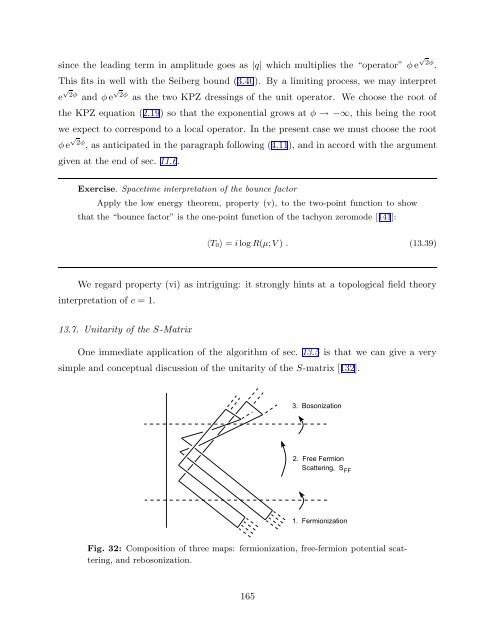arXiv:hep-th/9304011 v1 Apr 5 1993
arXiv:hep-th/9304011 v1 Apr 5 1993
arXiv:hep-th/9304011 v1 Apr 5 1993
Create successful ePaper yourself
Turn your PDF publications into a flip-book with our unique Google optimized e-Paper software.
since <strong>th</strong>e leading term in amplitude goes as |q| which multiplies <strong>th</strong>e “operator” φ e √ 2φ .<br />
This fits in well wi<strong>th</strong> <strong>th</strong>e Seiberg bound (3.40). By a limiting process, we may interpret<br />
e √ 2φ and φ e √ 2φ as <strong>th</strong>e two KPZ dressings of <strong>th</strong>e unit operator. We choose <strong>th</strong>e root of<br />
<strong>th</strong>e KPZ equation (2.19) so <strong>th</strong>at <strong>th</strong>e exponential grows at φ → −∞, <strong>th</strong>is being <strong>th</strong>e root<br />
we expect to correspond to a local operator. In <strong>th</strong>e present case we must choose <strong>th</strong>e root<br />
φ e √ 2φ , as anticipated in <strong>th</strong>e paragraph following (4.11), and in accord wi<strong>th</strong> <strong>th</strong>e argument<br />
given at <strong>th</strong>e end of sec. 11.6.<br />
Exercise. Spacetime interpretation of <strong>th</strong>e bounce factor<br />
Apply <strong>th</strong>e low energy <strong>th</strong>eorem, property (v), to <strong>th</strong>e two-point function to show<br />
<strong>th</strong>at <strong>th</strong>e “bounce factor” is <strong>th</strong>e one-point function of <strong>th</strong>e tachyon zeromode [141]:<br />
〈T 0 〉 = i log R(µ; V ) . (13.39)<br />
We regard property (vi) as intriguing: it strongly hints at a topological field <strong>th</strong>eory<br />
interpretation of c = 1.<br />
13.7. Unitarity of <strong>th</strong>e S-Matrix<br />
One immediate application of <strong>th</strong>e algori<strong>th</strong>m of sec. 13.5 is <strong>th</strong>at we can give a very<br />
simple and conceptual discussion of <strong>th</strong>e unitarity of <strong>th</strong>e S-matrix [132].<br />
3. Bosonization<br />
2. Free Fermion<br />
Scattering, S FF<br />
1. Fermionization<br />
Fig. 32: Composition of <strong>th</strong>ree maps: fermionization, free-fermion potential scattering,<br />
and rebosonization.<br />
165
















